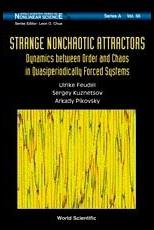A concept of strange nonchaotic attractor (SNA) was introduced in 1984 by C.Grebogi, E.Ott, S.Pelikan, J.Yorke (Physica D13, 261) and relates to a special class of dissipative systems, with quasiperiodic driving. In these systems an instant state is defined by a set of variables, the generalized coordinates, relating to the system itself, and the phases, whose nomber equals to the nomber of components of the external driving with incommensurate frequencies. The epithet 'strange' sets SNA against the torus-attractor, which has a smooth dependence of coordinate variables on phases. The adjective 'nonchaotic' distinguishes it from the strange chaotic attractor, which is characterized by presence of exponential instability of trajectories. As found, in the region between order and chaos SNA is as a typical phenomenon. It may be said that in these systems the 'strangeness' appears first, and only then transition to chaos occurs. This web-page is devoted to a review of problems associated with SNA, and has been prepared under support of a grant of RFBR No 03-02-16074 and a grant of RFBR and DFG No 04-02-04011. Original results relate to the renormalization group approach to the birth of SNA.
As a curious exemplar in a 'Zoo' of phenomena of nonlinear dynamics, the SNA obviously deserves attention of specialists working with oscillations in externally driven systems (mechanical constructions, electronic devices, etc.). As a possible application, one can mention a possibility of use of SNA in schemas of secure communications (Ramaswamy, Phys. Rev. E56, 1997, 7294; Zhou and Chen, Europhys. Lett., 38, 1997, 261).
Here we want to outline a more fundamental aspect. As known, on an early stage of discussion of onset of turbulence, Landau has suggested a scenario (Doklady Acad. Sci. USSR, 44, 1944, 339), in which the turbulence appears in a course of increase of Reynolds number in hydrodynamic flows as result of a series of subsequent bifurcations each of which gives rise to an oscillatory motion of a new incommensurate frequency. In presence of a large number of such frequencies the dynamics is perceived as 'turbulent'. This picture was criticized by Ruelle and Takens (1971). They advansed an idea of strange chaotic attractor, which should appear already after a birth of three independent frequency components. The argumentation is so common that has equal relation to hydrodynamic flows and to complex nonlinear dissipative systems of any physical nature. Since these pioneering works, a great progress is achieved in studies of transitions to chaos via quasiperiodicity, but it is clear that the entire picture is extremely complex and far from complete understanding.
One of possible approaches is to turn to a simplified problem. Say, we may assume that in some complex system with multi-dimensional phase space oscillations with incommensurate frequencies are quasi-independent and effect unidirectionally onto a born additional oscillatory mode. It leads to models with quasiperiodic driving discussed in the present review. In this approach the frequencies are regarded as independent parameters designated by a researcher. It gives opportunities to handle the model freely and analyze dynamics in dependence of the frequency parameters. It is remarkable, that on this way a story makes an unexpected turn: beside regular and chaotic dynamics a novel type of behavior can be observed, that associated with SNA.
As stated, in systems with quasiperiodic driving SNA regimes occupy a set of positive measure, and, hence, the SNA has to be regarded as a typical phenomenon between order and chaos. In autonomous systems frequencies of oscillatory components are generated by intrinsic dynamics and do not allow simple and direct control. In this situation realization of SNA as a typical phenomenon is problematic. Generally speaking, at some points in the parameter space SNA will occur, but how notable is the set of these points in the parameter space and does it has non-zero measure, is not clear. A few reports in literature on observation of SNA in autonomous systems do not look convincing.
